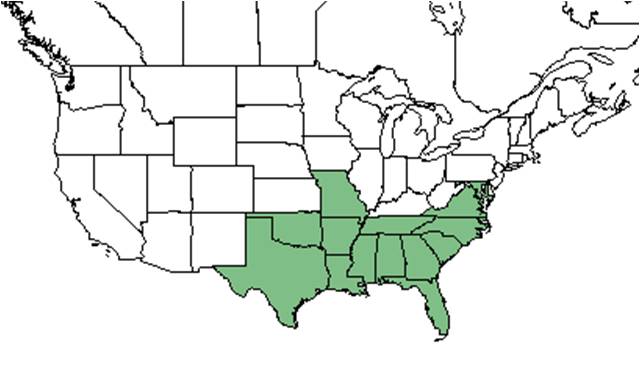Difference between revisions of "Callicarpa americana"
(→Ecology) |
(→Description) |
||
| Line 21: | Line 21: | ||
==Description== | ==Description== | ||
<!-- Basic life history facts such as annual/perrenial, monoecious/dioecious, root morphology, seed type, etc. --> | <!-- Basic life history facts such as annual/perrenial, monoecious/dioecious, root morphology, seed type, etc. --> | ||
| − | Generally for the ''Callicarpa'' genus, they grow up to 1-2.5 m tall with twigs having stellate pubescence while being scrurfy when touched. The leaves are simple, opposite or subopposite, have short pubescent above, and ovate, ovate-lanceolate, or elliptic, acute to acuminate, petiolate in shape. The flowers are in axillary cymes. The calyx is shallowly 5-toothed, grows 0.5-2 mm long. The petals are united ca. 1/2-2/3 their length. The lobes 5, are spreading, are lavender to pinkish in color, grow 3-5 mm long. The stamens are exserted. The stigma is slightly 2-lobed. The drupe is 4-seeded, are lavendar to purple in color, are rarely white in color, and are globose. The seeds are light yellow to brown in color, are ellipsoid to orbicular rounded on the back, and are flattened on the inner surface | + | Generally for the ''Callicarpa'' genus, they grow up to 1-2.5 m tall with twigs having stellate pubescence while being scrurfy when touched. The leaves are simple, opposite or subopposite, have short pubescent above, and ovate, ovate-lanceolate, or elliptic, acute to acuminate, petiolate in shape. The flowers are in axillary cymes. The calyx is shallowly 5-toothed, grows 0.5-2 mm long. The petals are united ca. 1/2-2/3 their length. The lobes 5, are spreading, are lavender to pinkish in color, grow 3-5 mm long. The stamens are exserted. The stigma is slightly 2-lobed. The drupe is 4-seeded, are lavendar to purple in color, are rarely white in color, and are globose. The seeds are light yellow to brown in color, are ellipsoid to orbicular rounded on the back, and are flattened on the inner surface. <ref name=rad> Radford, Albert E., Harry E. Ahles, and C. Ritchie Bell. Manual of the Vascular Flora of the Carolinas. 1964, 1968. The University of North Carolina Press. 894. Print. </ref> |
| − | Specifically, for ''Callicarpa americana'', the leaves are ovate to ovate-lanceolate in shape, there are stellate pubescence beneath the leaves, and grow 7-15 cm wide, are crenate to serrate, and at the base are widely cuneate or rounded. The petioles grow 1.5-3.5 cm long, and are scurfy stellate like the twigs. The cymes are shorter than the subtending petioles. The peduncles grow 1-5 mm long. The drupe grows 3-5 mm long. The pyrenes grow 2.3 mm long | + | Specifically, for ''Callicarpa americana'', the leaves are ovate to ovate-lanceolate in shape, there are stellate pubescence beneath the leaves, and grow 7-15 cm wide, are crenate to serrate, and at the base are widely cuneate or rounded. The petioles grow 1.5-3.5 cm long, and are scurfy stellate like the twigs. The cymes are shorter than the subtending petioles. The peduncles grow 1-5 mm long. The drupe grows 3-5 mm long. The pyrenes grow 2.3 mm long. <ref name=rad/> |
==Distribution== | ==Distribution== | ||
Revision as of 20:12, 21 April 2016
| Callicarpa americana | |
|---|---|

| |
| Photo taken by Kevin Robertson (2015) | |
| Scientific classification | |
| Kingdom: | Plantae |
| Division: | Magnoliophyta - Flowering plants |
| Class: | Magnoliopsida - Dicotyledons |
| Order: | Lamiales |
| Family: | Verbenaceae |
| Genus: | Callicarpa |
| Species: | C. americana |
| Binomial name | |
| Callicarpa americana L. | |

| |
| Natural range of Callicarpa americana from USDA NRCS Plants Database. | |
Common name: American beautyberry
Contents
Taxonomic notes
Description
Generally for the Callicarpa genus, they grow up to 1-2.5 m tall with twigs having stellate pubescence while being scrurfy when touched. The leaves are simple, opposite or subopposite, have short pubescent above, and ovate, ovate-lanceolate, or elliptic, acute to acuminate, petiolate in shape. The flowers are in axillary cymes. The calyx is shallowly 5-toothed, grows 0.5-2 mm long. The petals are united ca. 1/2-2/3 their length. The lobes 5, are spreading, are lavender to pinkish in color, grow 3-5 mm long. The stamens are exserted. The stigma is slightly 2-lobed. The drupe is 4-seeded, are lavendar to purple in color, are rarely white in color, and are globose. The seeds are light yellow to brown in color, are ellipsoid to orbicular rounded on the back, and are flattened on the inner surface. [1]
Specifically, for Callicarpa americana, the leaves are ovate to ovate-lanceolate in shape, there are stellate pubescence beneath the leaves, and grow 7-15 cm wide, are crenate to serrate, and at the base are widely cuneate or rounded. The petioles grow 1.5-3.5 cm long, and are scurfy stellate like the twigs. The cymes are shorter than the subtending petioles. The peduncles grow 1-5 mm long. The drupe grows 3-5 mm long. The pyrenes grow 2.3 mm long. [1]
Distribution
Ecology
Pollination
The following Hymenoptera families and species were observed visiting flowers of Callicarpa americana at Archbold Biological Station (Deyrup 2015):
Apidae: Apis mellifera
Halictidae: Agapostemon splendens, Augochlora pura, Halictus poeyi, Lasioglossum placidensis
Megachilidae: Megachile brevis pseudobrevis
Conservation and Management
Cultivation and restoration
Photo Gallery
References and notes
Deyrup, M.A. 2015. Database of observations of Hymenoptera visitations to flowers of plants on Archbold Biological Station, Florida, USA.
Radford, Albert E., Harry E. Ahles, and C. Ritchie Bell. Manual of the Vascular Flora of the Carolinas. 1964, 1968. The University of North Carolina Press. 894. Print.